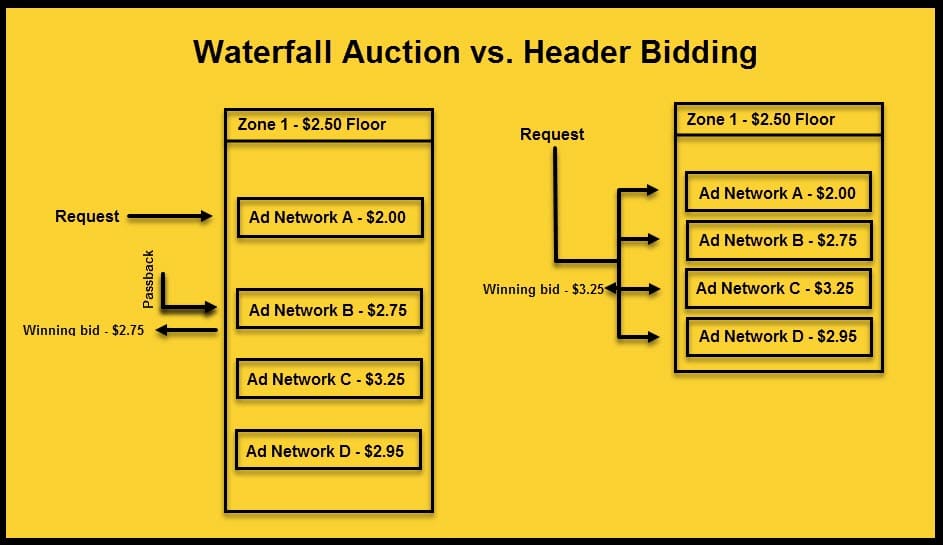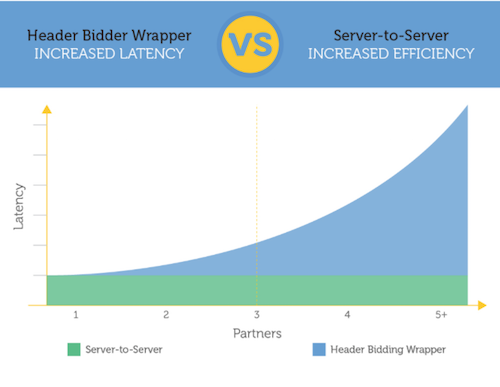While more efficient than traditional ad buying, programmatic ad buying still has its drawbacks. Among them are lost revenue for publishers and low-quality ad inventory for buyers. A few years ago, header bidding emerged as a potential answer to that problem. Today, though, many still find it an industry mystery that needs clearing up. According to a survey from eMarketer, only 21% of marketers have a good understanding of what header bidding is:

What is header bidding?
Header bidding is an advanced method of programmatic ad buying which allows publishers to offer their inventory to multiple ad exchanges before requesting ad servers. This contrasts the waterfall method, which can rob advertisers of premium inventory and publishers of maximum revenue.
Real-time bidding and the waterfall
Real-time bidding (RTB) is the process of auctioning off ad space in real time. To maximize their revenue during an RTB auction, publishers offer their ad space to the highest bidders in a cascading fashion. After direct deals are filled, unfilled inventory is offered to bidders one ad exchange at a time. In the first exchange, if nobody bids over the publisher’s price floor, inventory is sent the next network with a lower price floor, and then the next, until someone bids high enough or the publisher calls its ad server, like DoubleClick for Publishers. The system is called a waterfall. It works, but inefficiently. At AdProfs, they explain it well:
It’s like offering a bag of apples to four different people, one after another, lowering the price whenever someone rejects the apples. Eventually someone might say yes because of the bargain, but that isn’t how you get the best price for your apples. Furthermore, it gives the impression that you’re selling low-grade apples—apples that many people already rejected.
The major problem with this method is that someone in a lower of stage of the waterfall may be willing to pay more than someone higher. But, if a bid is accepted higher up, they’ll never get the chance.
Using header bidding, though, everybody bids at the same time. That can quickly earn publishers more revenue while also giving all advertisers an equal shot at higher quality placements.
How does header bidding work?
To work, header bidding hinges on a piece of JavaScript in the header of a publisher’s page that allows buyers to bid on advertising. It works like this: First, a user clicks through to a website. Then, the publisher’s header tag requests several ad networks. The ad networks place their bids, and then, the winning bid is passed to the publisher’s ad server:

Finally, the publisher’s ad server connects the user to the advertiser’s server, which shows the winning ad creative. Advertisers can win header bids for any inventory as long as their bids are high enough and they don’t interrupt the delivery of direct orders.
This method flattens the waterfall and lets publishers know exactly what each advertiser is willing to bid before the publisher calls its ad server. Ultimately, with header bidding, publishers can maximize revenue and advertisers cement better exposure for their brand.
Header bidding implementation
For publishers, implementing header bidding can be a complicated and counterintuitive process. The setup is tedious, forcing its adopters to develop countless line items for their ad inventory. The team at Ad Ops says “Header tag integrations require a much, much heavier upfront lift in terms of trafficking line items. It’s not just a little more work, it’s probably 100X as much work to traffic for most publishers.”
What’s more, even after setup, header bidding can kill page load speed. Third-party tags that enable header bidding, like any third-party tag, bog the page down. They make it load more slowly. And if visitors are abandoning your page before it loads, they’re not seeing any ads. Publishers are not earning revenue.
Trends in header bidding
A few new technologies have cropped up to solve slow page loads. The first is header bidding wrappers, used by publishers who work with a variety of header bidding solutions. These code containers ensure that all auctions start at the same and end in a timely manner. It can also mandate that all ads load asynchronously, which means the page’s content can load before the ads do.
The second potential solution is server-side header bidding. Traditionally all header bidding has been client-side, also known as browser-side, meaning it relies on the browser to handle requests from individual networks. Header wrappers can streamline the process to an extent, but if there are lots of networks accessing the header wrapper, it’s going to trigger a lot of JavaScript processes. And that’s going to slow the load time of the page.
Some publishers have attempted to limit excessive processes by capping the number of bidders per auction, but that defeats the purpose of using header bidding in the first place: more advertisers, more bids, more revenue.
Server-side header bidding, on the other hand, takes all the heavy requests on the browser and moves them to an external server. It still requires the publishers embed some code on the back-end of their web pages, but all the legwork is transferred from the browser to the ad server. Ultimately it’s faster.

The browser can focus on what it does best — displaying your web page to the viewer, while the auction takes place on a separate server. This process takes much less work on the publisher’s end to set up.
Pros and cons of header bidding
It’s pretty easy to see why publishers are choosing to move from the waterfall to the header. For publishers:
- More options: Working with only one SSP means working with their sources of demand. Those sources are incomplete. The more bids you can get from advertisers, the more demand you’ll have.
- Header bidding also allows you, ahead of time, to know what’s being bid, as opposed to creating a pricing floor and moving to successive stages of the waterfall when it’s not met.
- More advertisers, more bids, more options are likely to drive bids up. That, ultimately, means more revenue for publishers.
- For buyers, header bidding means access to higher-quality placements — even premium ones — that were once reserved strictly for direct deals.
- A major drawback of header bidding, however, is its setup. While it’s getting easier as the technology matures, it’s still a tedious upfront task to get started, requiring line items to be built into the header of countless pages.
- The biggest issue is with page load time. Ultimately, this comes down to creating a great user experience. If the page doesn’t load quickly, the user won’t stick around. If the user doesn’t stick around to see the ad load, it doesn’t matter how much you’re offered for an impression.
Create high-yield ads and high-yield post-click landing pages
For publishers, header bidding can maximize revenue. For advertisers, it allows access to higher-quality placements, but only at higher costs. When you’re paying top dollar for premium ad space, you can’t afford to waste a single impression. Remember, the click-through happens at the ad, but the conversion happens on the post-click landing page. Begin creating a conversion-worthy post-click landing page with the most robust post-click automation solution. Sign up for an Instapage Enterprise demo here.

See the Instapage Enterprise Plan in Action.
Demo includes AdMap™, Personalization, AMP,
Global Blocks, heatmaps & more.
